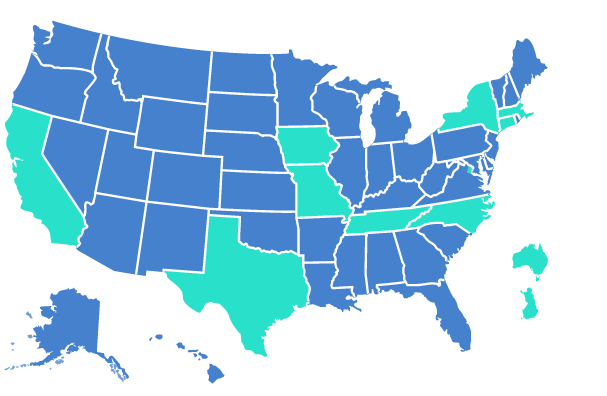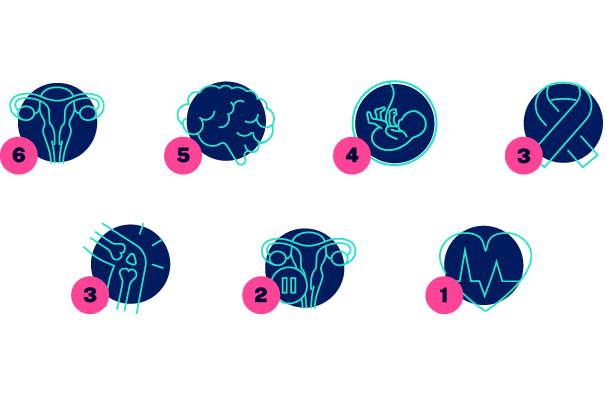Sprint for Women’s Health
The ARPA-H Sprint for Women’s Health addresses critical unmet challenges in women’s health and champions transformative innovations.
Breakthrough innovations to transform women’s health
The Advanced Research Projects Agency for Health (ARPA-H) supports biomedical and health breakthroughs to accelerate better health outcomes for everyone. Through our Sprint for Women’s Health, we are championing transformative innovations and answering critical unmet challenges in women’s health across all demographics, geographies, and socioeconomic statuses.
This initiative seeks to galvanize the innovator, investor, researcher, and patient advocate communities around solving specific problems, including brain, reproductive, and cardiovascular health. Two funding tracks are fostering transformative research & development (R&D) efforts—from “Spark” (early-stage research) to “Launchpad” (later-stage development)—to greatly improve women’s health outcomes.

Women’s Health Topics
Sprint by the numbers

More than 1700 submissions were received from over 30 countries.

Research teams from around the country and the globe are from universities, small businesses, and industry.

Awarded projects span many technological areas.

Awarded projects include conditions that uniquely and disproportionally affect women.
$113M
invested to address health conditions uniquely or disproportionately impacting women
Over 70% of projects are woman-led
6
months from concept to award
9 projects awarded to small businesses or startups
30%
have never received government funding before
39% of projects awarded to colleges or universities
Use these social media resources to share news about the ARPA-H Sprint for Women's Health awardees.
For more information on how the Sprint was organized, visit the ARPA-H Investor Catalyst Hub website.
ARPA-H is pleased to announce the following Sprint for Women’s Health awardees.
Topic 1: Women's Health at Home
Revolutionizing At-Home Preeclampsia Detection
What if we could reliably predict preeclampsia in pregnant women with an at-home test?
Preeclampsia (PE) complicates 5-7% of pregnancies and is a major cause of maternal and neonatal morbidity and mortality. Accurate diagnosis remains a key challenge. We have some molecular tests for this condition, but they rely on expensive, blood-based platforms – systems that require trained laboratory technologists and hospital-based laboratories. Our goal is to develop and validate a point-of-care test that can be readily used by mothers at home for early detection of PE.
Topic 1: Women's Health at Home
Paradigm Shift for Early At-Home HPV Management
What if we could offer a simple and inexpensive home-based HPV cure for women worldwide?
Daré Bioscience is developing the first treatment for clearance of persistent high-risk human papillomavirus (hrHPV) infection, which causes cervical cancer. The product, called DARE-HPV, is a soft gel vaginal insert containing two antiretroviral drugs, lopinavir and ritonavir, which are well-known and already have demonstrated safety. The novel aspects of DARE-HPV are that (1) it is a minimally invasive home-use product that intervenes earlier on the path to cervical cancer; and (2) because of this early intervention, DARE-HPV aims to enable women to address their cervical health at home, eliminating the frequent “watchful waiting” visits to a health care provider that are costly, burdensome, and contribute to socioeconomic and racial disparities in cervical cancer.
Topic 1: Women's Health at Home
Fast and Affordable Home STI/UTI Test
What if women of any age could diagnose multiple infections by one inexpensive test at home?
Due to poor prevention strategies, a lack of at-home affordable rapid tests for sexually transmitted infections (STIs), and changes in sexual behavior in the population, alarming rates of STIs such as chlamydia and syphilis are today exploding. Unfortunately, women are the ones who face some of the biggest impacts and most significant consequences of these diseases. We aim to develop a new device, the NanoBioChip, based on a semiconductor microchip, for at-home diagnostics, which offers rapid (within minutes) and low cost (~ $25) detection of multiple (up to 50) STIs/UTIs pathogens, while also ensuring effortless compatibility with Wi-Fi and smart phones.
Topic 1: Women's Health at Home
At-Home Treatment to Stop Preterm Labor
What if we could eradicate preterm delivery with a simple labor-halting drug administered at home?
We aim to develop an at-home treatment for preterm labor that involves an antibody-drug conjugate or small-molecule drug conjugate that displays selective delivery of drugs to the uterus to inhibit uterine contractions and reduce the side-effect profiles for current off-label medications.
Topic 1: Women's Health at Home
Home-Based Safe & Intelligent Labor Inductions
What if we could conduct remote maternal and fetal monitoring to enable safe and comfortable labor induction at home?
We aim to develop a wireless sensor system that facilitates remote monitoring of maternal and fetal biometrics to enable data-driven decision-making. In the United States, this solution has the potential to reduce nearly $800 million in insurance costs yearly. Our goal is to enhance the quality of outpatient labor induction for a growing number of high-risk pregnancies.
Topic 2: Prioritizing Ovarian Health
Extend Ovarian Function & Lifespan
What if one drug could delay menopause to promote longevity and overall health?
Menopause is the single biggest accelerant of unhealthy aging for women. There are currently no therapeutic interventions that directly address this health challenge. We aim to develop a groundbreaking therapeutic to improve and extend ovarian function throughout a woman’s lifespan by targeting a key regulator of ovarian function. The proposed studies will enable us to test various molecular approaches to develop a first-of-its-kind ovarian therapeutic, which will reach preclinical development milestones by the end of the funding period.
Topic 2: Prioritizing Ovarian Health
Ovarian Implants to Prevent Disease in Menopause
What if women’s long-term health could be protected by eliminating the adverse effects of menopause?
Menopause, defined as the cessation of ovarian function, is a universal experience of all healthy women later in life. Because of its significant health impacts, menopause is associated with increased risk of major morbidities, including cancer, dementia, and cardiovascular disease. We propose constructing a cell-therapy implant made of human induced pluripotent stem cell-derived ovarian tissue and a supportive hydrogel matrix, which, when implanted in the body, will replace deficient ovarian function, restore normal hormonal processes, manage menopause-associated symptoms, and minimize the adverse health outcomes related to menopause.
Topic 3: ARTEMIS: Modeling Sex Differences
Bioengineered Ex Utero Drug Testing Model
What if we definitively knew which medications were safe during pregnancy without needing to test these drugs?
More than 90% of FDA-approved drugs are not recommended for use during pregnancy, mostly because there are insufficient data to make conclusions about safety for the fetus. Our objective is to develop a model of human pregnancy that can be used to study how drugs interact with the placenta, the unique organ that protects and nourishes the fetus, and determine if certain drugs are safe. We intend to design a platform that will allow us to test dozens of drugs at a time. Our long-term vision is to use the platform to test all FDA-approved drugs, model pregnancy disorders, identify appropriate drug dosing, or even mimic clinical trials in the lab.
Topic 4: Women's Brain Health
Near-Infrared Glymphatic Health Tracker (NIGHT) Study
What if women could achieve restorative sleep and mitigation of neurodegenerative diseases?
We aim to address a critical need for women's health by enabling effortless monitoring of the glymphatic system (GS) function at home with a wireless NIRS-EEG device during naturalistic sleep. Women face a substantially higher risk of Alzheimer’s disease (AD), yet existing methods for assessing GS function are limited and impractical. By offering a non-invasive, cost-effective solution tailored for home use, our GS-FlexNIRS-EEG device could provide valuable insights into GS dysfunction in women, potentially leading to early detection and personalized interventions to mitigate their heightened risk of neurodegenerative disorders like AD.
Topic 4: Women's Brain Health
Female Lymphatic GPCR Therapeutics (FLyGT) for Migraine Treatment
What if we could design a personalized treatment to reduce women’s debilitating migraines?
We plan to elucidate the role of meningeal lymphatics in migraine, a debilitating neurological condition with high prevalence in women. Our breakthrough data shows that calcitonin gene related peptide (CGRP), which is elevated during migraine, reduces lymphatic drainage resulting in neuroinflammation and pain. We will use the UNC Collaborative Cross to genetically map the variance of meningeal lymphatics between sexes and screen for loci that modify female prevalence of pain and lymphatic flow during migraine. Spatial transcriptomics and custom-designed molecular beacons will be used to illuminate and pharmacologically define the druggable receptor repertoire of lymphatics. These newly developed anti-CGRP drugs will be tested in a clinical study with MRI imaging. Collectively we aim to “Take FLyGT” by accelerating the pace of Female Lymphatic GPCR Therapeutics for Migraine Treatment.
Topic 4: Women's Brain Health
MAGNifying Glymphatics in Women’s Brains
What if we could identify neurophysiological sex disparity rationale in cognitive decline?
We seek to investigate the unique physiology of the meningeal lymphatic and glymphatic system. By leveraging the performance capabilities only accessible with the high-performance head-only 3.0-Tesla MRI gradient, we aim to develop a suite of tailored MRI acquisitions targeted to in-vivo functional and structural mapping of the brains meningeal lymphatic vasculature and glymphatic system and without contrast agent. With an emphasis on validation with healthy brains, we aim to shed light on the unique physiology of the systems behind the brain’s clearance mechanism as a function of both sex differentiation and age.
Topic 4: Women's Brain Health
Nano-drug Delivery Devices (NANO-3D) for Ischemic Stroke
What if we could improve stroke outcomes for women with simple non-invasive therapies?
This project aims to develop nano-drug delivery (NANO-3D) devices that non-invasively regulate the brain’s lymphatic system to treat ischemic stroke. The project also expects to generate new knowledge about the variability in brain-draining lymphatic vasculature with sex and age which will inform the pathology of stroke and other neurological diseases. This will provide substantial benefit to the ¼ women who experience ischemic stroke. The current treatment for ischemic stroke consists of “clot-busting” drugs or invasive clot retrieval. These approaches are only effective if performed within a few hours after stroke, have significant bleeding risk, and are resource intensive. Our NANO-3D devices promote pumping of the cervical lymphatic vessels in the neck to enhance the removal of fluid and toxic waste products from the brain. This addresses the need for simple, cost-effective, non-invasive, and safe mechanism to enhance waste removal from the brain to treat ischemic stroke.
Topic 4: Women's Brain Health
Evaluate Brain Disorders in Women via Aquaporin Activity
What if we could use non-invasive imaging to understand how biological sex affects the health of women's brains?
Glymphatic function is believed to play a key role in brain disorders which profoundly affect women’s health, yet glymphatic function is not currently assessed clinically. We propose validation and commercialization of a noninvasive MRI metric of glymphatic function that has the potential to revolutionize how the numerous neurological disorders which are more prevalent in women can be understood, assessed clinically, and approached therapeutically.
Topic 4: Women's Brain Health
Clear Brain Toxins in Women with Focused Ultrasound
What if we could treat neurodegenerative disorders and age-related cognitive decline in women by enhancing brain lymphatic flow with just a single injection and ultrasound?
With women having longer lifespans, this aging population have an increased susceptibility to dementia and neurodegenerative disorders, accounting for 2 of 3 diagnosed patients. Glymphatic function is believed to facilitate cerebral clearance of toxins which contributes significantly to maintaining brain health and slowing progression of age-associated cognitive decline. Pushing the boundaries of innovation, we will demonstrate the possibility of combining a novel targeted drug with focused ultrasound to activate brain clearance and pave way to design an at-home therapeutic treatment solution.
Topic 5: Measurements of Chronic Pain
Decoding Pain Through a Blood Test
What if a blood-based assay could identify and quantify endometriosis pain levels informing treatment?
Chronic pain afflicts millions of women, with conditions like endometriosis often misdiagnosed due to subjective reporting limitations. We propose a groundbreaking solution: a first-in-class blood test that deciphers unique molecular pain signatures, paired with a mobile app that tracks subjective symptoms and objective behavioral data. This comprehensive approach promises objective diagnosis, personalized treatment plans, and improved outcomes for women with chronic pain. Beyond endometriosis, this innovation could revolutionize the diagnosis and management of other debilitating conditions.
Topic 5: Measurements of Chronic Pain
Multi-Modal Smart Band-Aid for AI Pain Quantification
What if women's pain could be quantitatively assessed in real time with wearable sensors?
Our objective is to develop tools and methods to quantify nociceptive pain and neuropathic pain. This project aims to quantify pain objectively based on a wide panel of biophysical and biochemical markers. The platform is based on a smart “band-aids:” a self-powered biochemical sensing patch to monitor a suite of chemical biomarkers in interstitial fluid, a non-invasive source of biomarkers. Importantly, the use of artificial intelligence and machine learning will be utilized to develop a single objective score of pain.
Topic 5: Measurements of Chronic Pain
Wearable Sweat Sensing System for Chronic Pain
What if a sweat measurement sensed and tracked women's pain levels over time?
We hypothesize that the quantitative, non-invasive analysis of key sweat analytes — including glutamate, tryptophan, cortisol, estradiol, as well as serotonin and substance P— coupled with vital signs, could revolutionize chronic pain assessment by making it objective and personalized. This project seeks to develop a wireless multimodal wearable system to simultaneously monitor these sweat analytes along with vital signs. Through monitoring sweat biomarkers along with vital signs in women subjects with menstrual migraines using a single integrated wearable system and analyzing the data with machine learning, we could predict the levels of pain in real time.
Topic 5: Measurements of Chronic Pain
Novel Physiologic Measure of Chronic Pain in Women
What if women's eyes provided a window into their pain?
This project will work to develop a physiologic biomarker that enables an objective characterization of pain type and intensity. When fully developed, this technology will serve as an objective measure of pain, enabling disease agnostic, non-invasive, point-of-care assessments, and monitoring of treatment efficacy in women with chronic pain.
Topic 6: Revolutionary Breakthroughs
Implantable Lymphoid Organ Cancer Therapy
What if your own tumors could be converted to help fight ovarian cancer?
Ovarian cancer patients who beat the odds and survive advanced cancer develop an immune command center within their tumor. These lymph node-like structures are called tertiary lymphoid organs and they reprogram the immune cells to attack the tumor and retain immune “memories” of the tumor. The goal of this project is to develop injectable lymphoid organs from the patient’s own blood cells to treat their ovarian cancer. Next, we will screen ovarian cancer cell lines and patient immune cells to identify which ovarian cancer subtypes may benefit from this approach right away. Finally, we will test the efficacy of injectable lymphoid organs in reducing tumor growth and recurrence in vivo and in vitro.
Topic 6: Revolutionary Breakthroughs
Eradicate Ovarian Cancer Now by Personalized Nanoparticles
What if boosting the immune system treated late-stage and metastatic ovarian cancer?
Ovarian cancer, our initial test case, needs novel, effective, and non-toxic treatment strategies. Macrophage engineered vesicles are a platform technology that harnesses the power of immune cell-derived extracellular vesicles to modulate the tumor microenvironment. This is a paradigm shift in the field of extracellular vesicles, where instead of isolating extracellular vesicles released by cells, we are engineering them from the cell of interest. This retains desirable cancer targeting and tumor microenvironment modulation properties and overcomes previously insurmountable challenges in yield.
Topic 6: Revolutionary Breakthroughs
First Definitive & Non-Invasive Endometriosis Blood Test
What if we could diagnose endometriosis without surgery while finding new treatments?
Our project seeks to correct the weaknesses of the current endometriosis diagnostic paradigm. We will employ a multimodal approach that tracks disease progression to inform not just diagnosis, but longitudinally may be prognostic or even theragnostic for endometriosis therapeutic innovation.
Topic 6: Revolutionary Breakthroughs
OmniTACs to Fight Women's Cancer
What if the most common women's cancers could be cured by one drug?
The goal of this project is a groundbreaking therapeutic strategy against women's cancers using Induced Proximity Medicines (IPMs) to target a protein prevalent in breast and gynecological cancers. This innovative method selectively edits proteins by inducing proximity between effector proteins (EPs) and target proteins (TPs), modulating their therapeutic effects.
Topic 6: Revolutionary Breakthroughs
Revolutionizing Endometriosis Precision Medicine
What if diagnosing endometriosis was non-invasive and a personalized platform streamlined treatments?
This project outlines the construction of a novel precision medicine data platform with a goal to improve health outcomes for patients with endometriosis. By combining data from three entities in a consortium aligned to solve endometriosis, this project aims to develop a highly characterized non-invasive, multi-omic diagnostic signature for endometriosis. The platform will be informed through digitally enabled symptom management and detailed pharmacogenetic insights in order to offer individualized treatment plans. The integration of these technologies seeks to refine treatment strategies, improve diagnostic accuracy, and facilitate personalized medication matching while moving away from a trial-and-error approach, instead offering tailored treatment plans based on the distinct subtypes of endometriosis identified. A powered clinical study could validate this integrated approach, revolutionizing the management of endometriosis and leading to enhanced patient outcomes, fewer complications, reduced costs, and accelerated treatment.
Topic 6: Revolutionary Breakthroughs
Enabling New Therapies for Vaginal Health
What if balancing the vaginal microbiome could prevent recurrent infections and improve health?
We are developing a novel class of bacterial therapies to address a major underserved women’s health problem. The vaginal microbiome is a fundamental determinant of women’s health. It contains a multitude of bacterial viruses, also known as phages, which can drive disease and prevent the efficacy of novel bacterial therapies. Despite its importance, this ecosystem has remained understudied, thus hampering the development of new therapies. To overcome this, we have developed an innovative platform using advanced tools to (i) identify viruses in the vaginal tract, and (ii) harness native immune systems in bacteria to develop a new class of bacterial therapies that have viral immunity. Our goal is to develop novel therapies to treat bacterial vaginosis, which is strongly associated with preterm birth, sexually transmitted infections, and infertility.




